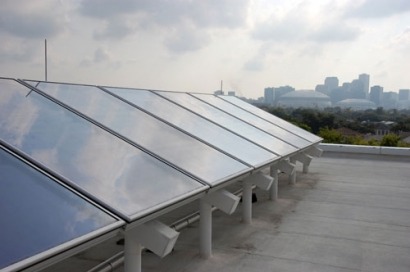
The Factbook documents the upward trajectory of energy efficiency, natural gas and renewable energy, using the latest data from 2013, adding yet another year of data reporting America’s long-term transition to cleaner, lower-carbon sources of energy production.
Despite the ever-shifting political position, the business case for efficient and sustainable energy sources has become even stronger in the US over the past year. Renewable energy provided 13 percent of US electricity generation in 2013, up from 12 percent in 2012 and just 8 percent in 2007. At the same time, renewable energy costs reached an all-time low, allowing clean energy, with the aid of incentives, to become cheaper than fossil fuel electricity in some parts of the country.
Meanwhile, small distributed generators and off-grid installations have begun to emerge as a transformative force in the power industry with financiers supporting the sector raising nearly $6.7 billion since 2008.
“The U.S. energy transformation that began in the mid-2000s gained additional momentum in 2013” said Lisa Jacobson, president of The Business Council for Sustainable Energy. “The Factbook plays a vital role in chronicling this fast-moving transformation, which is creating whole new industries and thousands of new jobs in the energy efficiency, natural gas and renewable energy sectors.”
The Factbook was commissioned by the Business Council for Sustainable Energy and tasked to Bloomberg New Energy Finance to research and write in order to provide policy makers, journalists and industry professionals with up-to-date, accurate market intelligence. There is an upward trend in energy efficiency financing with energy service companies and electric and gas utilities spending more than $12 billion in 2012. Meanwhile, 31 states and the District of Columbia, representing 77 percent of the U.S. population, have legislation in place to enable the financing of energy efficiency via property-assessed clean energy programs (PACE). Technology for smart grids and smart homes is entering the market with the potential to be pervasive in the future, thereby driving further efficiency gains in the years ahead.
“The changes unfolding in the US energy industry have been profound and, by the typical time scale of the industry, abrupt” added Michel Di Capua, Head of North American Analysis for Bloomberg New Energy Finance. “The effects of these changes will be felt in seemingly every nook and cranny of the American economy, from military bases to manufacturing plants, from homes to highways. 2013 saw some detours from the long-term trends, but overall, it is clear that the long-term transformation of how the US produces and consumes energy continues.”
The pace of change in the US with regard to clean energy has faced a number of challenges, particularly from the political arena. For example, investment in wind power manufacturing and development slowed dramatically in 2013 due to the late extension of the wind Production Tax Credit (PTC), after its expiration at the end of 2012. The wind industry installed 600MW in 2013, compared to a record 13.8GW in 2012. Conversely, federal solar tax credits did not require renewal for 2013, which helped propel a dramatic 50 percent increase in cumulative solar installations, making the United States a leader in one of the world’s most dynamic new energy industries.
In the long run, global trends in technologies indicate that clean energy sources are positioned to be among the leading technologies with net energy imports in the US estimated to have fallen by 15 percent between 2012 and 2013 and by more than 50 percent since 2005. Energy efficiency, renewable energy and natural gas are mainly responsible for the nearly 10 percent decline in US greenhouse gas emissions since 2005, taking the country more than halfway to President Obama’s goal of achieving a 17 percent reduction in emissions by 2020.

